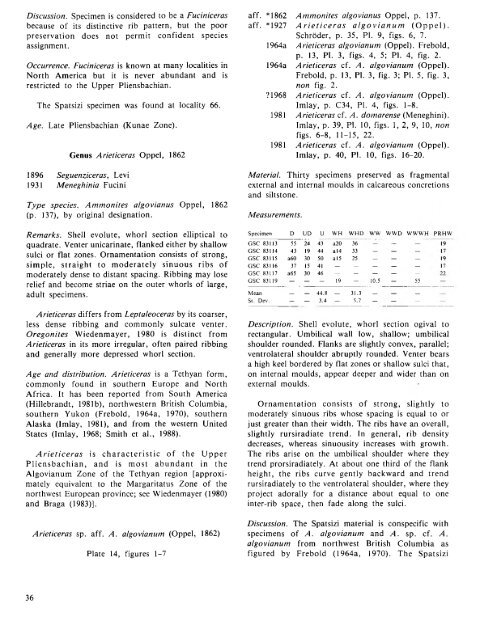PLIENSBACHIAN (LOWER JURASSIC) BIOSTRATIGRAPHY AND ...
PLIENSBACHIAN (LOWER JURASSIC) BIOSTRATIGRAPHY AND ...
PLIENSBACHIAN (LOWER JURASSIC) BIOSTRATIGRAPHY AND ...
Create successful ePaper yourself
Turn your PDF publications into a flip-book with our unique Google optimized e-Paper software.
Discussion. Specimen is considered to be a Fuciniceras<br />
because of its distinctive rib pattern, but the poor<br />
preservation does not permit confident species<br />
assignment.<br />
Occurrence. Fuciniceras is known at many localities in<br />
North America but it is never abundant and is<br />
restricted to the Upper Pliensbachian.<br />
The Spatsizi specimen was found at locality 66.<br />
A ge. Late Pliensbachian (Kunae Zone).<br />
Genus Arieticeras Oppel, 1862<br />
1896 Seguenziceras, Levi<br />
1931 M eneghinia Fucini<br />
Type species. A m m o n ites algovianus Oppel, 1862<br />
(p. 137), by original designation.<br />
Rem arks. Shell evolute, whorl section elliptical to<br />
quadrate. Venter unicarinate, flanked either by shallow<br />
sulci or flat zones. Ornamentation consists of strong,<br />
simple, straight to m oderately sinuous ribs of<br />
moderately dense to distant spacing. Ribbing may lose<br />
relief and become striae on the outer whorls of large,<br />
adult specimens.<br />
Arieticeras differs from Leptaleoceras by its coarser,<br />
less dense ribbing and commonly sulcate venter.<br />
O regonites Wiedenmayer, 1980 is distinct from<br />
Arieticeras in its more irregular, often paired ribbing<br />
and generally more depressed whorl section.<br />
A g e and distribution. Arieticeras is a Tethyan form,<br />
commonly found in southern Europe and North<br />
Africa. It has been reported from South America<br />
(Hillebrandt, 1981b), northwestern British Columbia,<br />
southern Yukon (Frebold, 1964a, 1970), southern<br />
Alaska (Imlay, 1981), and from the western United<br />
States (Imlay, 1968; Smith et al., 1988).<br />
A r ie tic e r a s is ch aracteristic of the U pper<br />
P liensbachian, and is m ost abundant in the<br />
Algovianum Zone of the Tethyan region [approximately<br />
equivalent to the Margaritatus Zone of the<br />
northwest European province; see W'iedenmayer (1980)<br />
and Braga (1983)].<br />
Arieticeras sp. aff. A . algovianum (Oppel, 1862)<br />
Plate 14, figures 1-7<br />
aff. *1862 A m m onites algovianus Oppel, p. 137.<br />
aff. *1927 A r i e t i c e r a s a lg o v ia n u m (O p p e l).<br />
Schroder, p. 35, PI. 9, figs. 6, 7.<br />
1964a Arieticeras algovianum (Oppel). Frebold,<br />
p. 13, PI. 3, figs. 4, 5; PI. 4, fig. 2.<br />
1964a A rieticeras cf. A . algovianum (Oppel).<br />
Frebold, p. 13, PI. 3, fig. 3; PI. 5, fig. 3,<br />
non fig. 2.<br />
71968 A rieticeras cf. A . algovianum (Oppel).<br />
Imlay, p. C34, PI. 4, figs. 1-8.<br />
1981 Arieticeras cf. A . domarense (Meneghini).<br />
Imlay, p. 39, PI. 10, figs. 1, 2, 9, 10, non<br />
figs. 6-8, 11-15, 22.<br />
1981 Arieticeras cf. A . algovianum (Oppel).<br />
Imlay, p. 40, PI. 10, figs. 16-20.<br />
Material. Thirty specimens preserved as fragmental<br />
external and internal moulds in calcareous concretions<br />
and siltstone.<br />
M easurements.<br />
Specim en D UD U W H W H D WW W W D W W W H<br />
G SC 83113 55 24 43 a20 36 — — —<br />
G SC 83114 43 19 44 a l4 33 — — —<br />
G SC 83115 a 60 30 50 a l5 25 — — —<br />
G SC 83116 37 15 41<br />
G SC 83117 a65 30 46 — — — — —<br />
G SC 83119 - - - 19 - 10.5 - 55<br />
M ean _ ___ 44.8 _ 31.3 _ ___ _<br />
St. Dev. - — 3.4 - 5.7 - — -<br />
D escription. Shell evolute, whorl section ogival to<br />
rectangular. Umbilical wall low, shallow; umbilical<br />
shoulder rounded. Flanks are slightly convex, parallel;<br />
ventrolateral shoulder abruptly rounded. Venter bears<br />
a high keel bordered by flat zones or shallow sulci that,<br />
on internal moulds, appear deeper and wider than on<br />
external moulds.<br />
Ornamentation consists of strong, slightly to<br />
moderately sinuous ribs whose spacing is equal to or<br />
just greater than their width. The ribs have an overall,<br />
slightly rursiradiate trend. In general, rib density<br />
decreases, whereas sinuousity increases with growth.<br />
The ribs arise on the umbilical shoulder where they<br />
trend prorsiradiately. At about one third of the flank<br />
height, the ribs curve gently backward and trend<br />
rursiradiately to the ventrolateral shoulder, where they<br />
project adorally for a distance about equal to one<br />
inter-rib space, then fade along the sulci.<br />
Discussion. The Spatsizi material is conspecific with<br />
specimens of A . algovianum and A . sp. cf. A .<br />
algovianum from northwest British Columbia as<br />
figured by Frebold (1964a, 1970). The Spatsizi

















